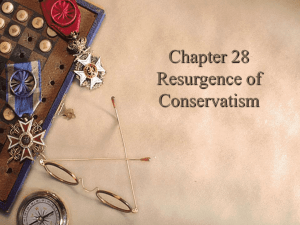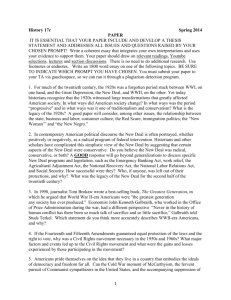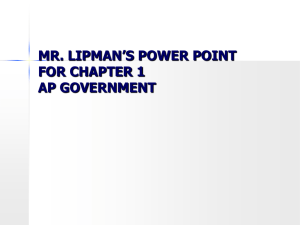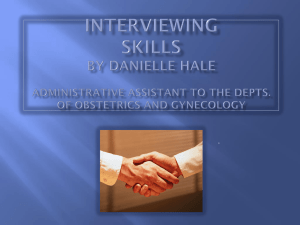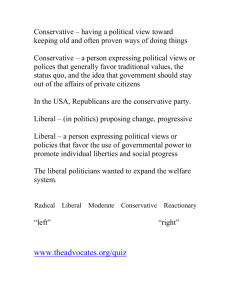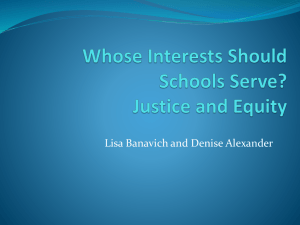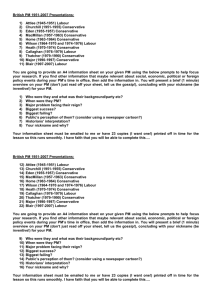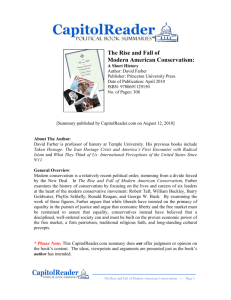Reagan`s Conservatism: Lasting Coalition?
advertisement
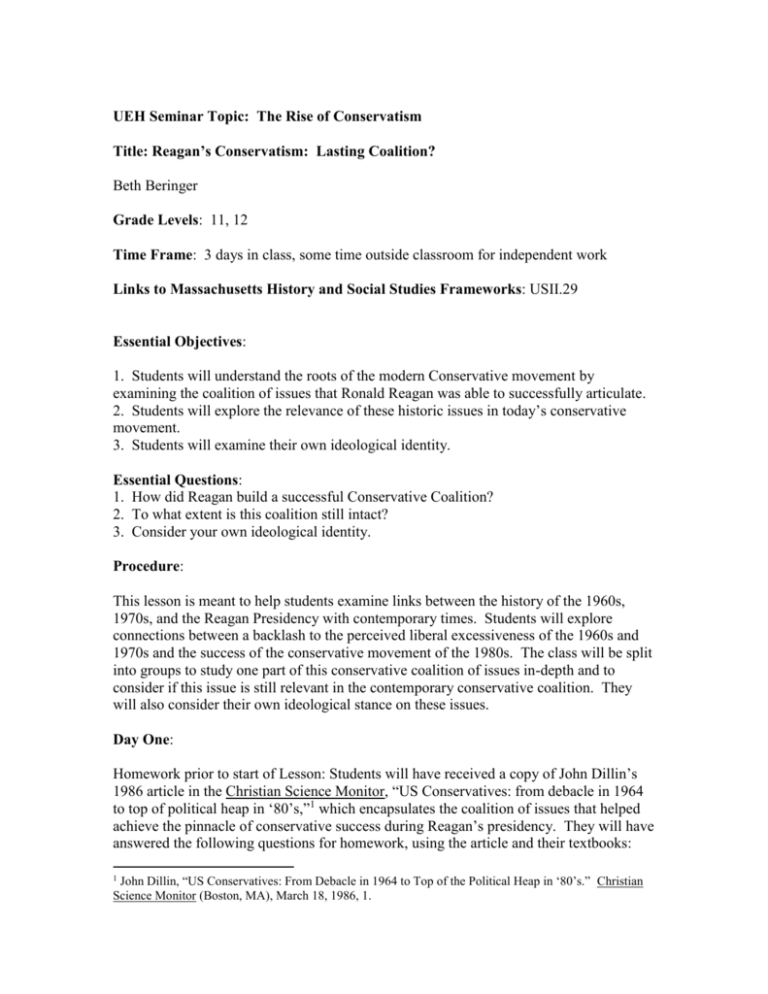
UEH Seminar Topic: The Rise of Conservatism Title: Reagan’s Conservatism: Lasting Coalition? Beth Beringer Grade Levels: 11, 12 Time Frame: 3 days in class, some time outside classroom for independent work Links to Massachusetts History and Social Studies Frameworks: USII.29 Essential Objectives: 1. Students will understand the roots of the modern Conservative movement by examining the coalition of issues that Ronald Reagan was able to successfully articulate. 2. Students will explore the relevance of these historic issues in today’s conservative movement. 3. Students will examine their own ideological identity. Essential Questions: 1. How did Reagan build a successful Conservative Coalition? 2. To what extent is this coalition still intact? 3. Consider your own ideological identity. Procedure: This lesson is meant to help students examine links between the history of the 1960s, 1970s, and the Reagan Presidency with contemporary times. Students will explore connections between a backlash to the perceived liberal excessiveness of the 1960s and 1970s and the success of the conservative movement of the 1980s. The class will be split into groups to study one part of this conservative coalition of issues in-depth and to consider if this issue is still relevant in the contemporary conservative coalition. They will also consider their own ideological stance on these issues. Day One: Homework prior to start of Lesson: Students will have received a copy of John Dillin’s 1986 article in the Christian Science Monitor, “US Conservatives: from debacle in 1964 to top of political heap in ‘80’s,”1 which encapsulates the coalition of issues that helped achieve the pinnacle of conservative success during Reagan’s presidency. They will have answered the following questions for homework, using the article and their textbooks: John Dillin, “US Conservatives: From Debacle in 1964 to Top of the Political Heap in ‘80’s.” Christian Science Monitor (Boston, MA), March 18, 1986, 1. 1 1. What do the “religious right,” the “economic right,” and the “foreign policy right” stand for, according to the article? 2. What evidence does the author give as to the success of the conservative agenda in Reagan’s policies? 3. What accounts for that success, according to the author? 4. According to your textbook, what are some of the other reasons for the success of the conservative movement in the 1980s, related to the backlash against the liberalism of the 1960s and 1970s? In class, after a discussion of the homework questions, and when the teacher sees that the class has a fairly good grasp of conservatism in this context, students will be told that the year is 1986 (the year the Christian Science Monitor article was written). It is the height of the conservative movement, and they are Reagan supporters and fellow conservatives. Based on their homework and what they know about the conservatism, they will be asked to respond to a set of sources. Students will work with partners. Taking on the conservative persona, they should prepare the following: Write a brief response to this source as a conservative. If the source has a “message,” do you agree with it? Why or why not? Be prepared to read your response to the class. Sources: A. Photograph of members of the New Buffalo Commune in the 1968 Fourth of July Parade (from A People and a Nation)2 B. Quote from Friedrich Hayek, “The more the state plans, the more difficult planning becomes for the individual.” C. It’s Nothin’ Personal, Folks…”3 cartoon by Clifford Baldowski, depicting Barry Goldwater shooting targets with government social safety net programs on them D. Quote from William F. Buckley, “I’d rather entrust the government of the United States to the first 400 people listed in the Boston telephone directory than to the faculty of Harvard University.” Teacher will discuss reactions with the class to further students’ understanding of conservative ideology. Students will now be introduced to the longer-range project associated with this topic, a project to be completed outside of class: 2 Mary-Beth Norton, ed. A People and a Nation (Boston: Houghton-Mifflin, 1990), 950. Clifford Baldowski, “Barry Goldwater- No Offense Folks,” University of Georgia Special CollectionsRichard Russell Library Online (http://www.lobs.uga.edu/russell/collections/baldy/index.shtml). 3 Project: You will now be asked to take one issue that was important in the formation of the “conservative coalition,” as described in the Christian Science Monitor article and your textbook. You will examine its historical origin, its effect in the Reagan coalition, and its relevance in the current conservative movement. You will also consider your own ideological leanings and where these feelings may come from. You will be assigned one of the following issues: abortion, religion and schools, “family values,” “supply-side economics,” tax policy, “hard-line” foreign policy, immigration Prepare the following: 1. Trace the roots of your issue in the Goldwater run for the Presidency in 1964. If the issue is a later addition to the conservative agenda, when is it added? What liberal policy is your issue a reaction to? 2. Assume the role of a conservative campaigner for Reagan. Present your issue in terms that would attract voters in the 1980s in a paragraph position statement. Use appropriately persuasive language to make your case --OR-- Create a political cartoon that showcases a conservative point of view about your issue in the Reagan years. 3. To what extent did the Reagan administration address your issue during his presidency? Were there any landmark pieces of legislation or significant events associated with your issue? Briefly explain. 4. Become a researcher of contemporary conservative ideology by listening to a conservative Talk Radio station or a conservative TV show. Do these pundits address your issue? Describe the language they use to define the issue. How have positions on the issue changed since the Reagan years? 5. Write a paragraph response to the following: Do you find conservative arguments persuasive? What is your own personal stance about the issue you have researched? What has brought you to this belief? Days Two- Three These days will occur after students have had time to complete their projects. Students will get together in issue groups and will be encouraged to share their findings with the class. Students should take notes on each other’s findings (with appropriate corrections by the teacher, if necessary). The teacher may want to spend more time having students voice their personal opinions about conservative issues. Teacher will then present a short excerpt from Thomas Frank’s What’s the Matter with Kansas?4 for the students to discuss. Students will be asked to critique Frank’s basic premise that modern conservatives use a “traditional values” agenda to gain workingclass support, but then create an economic climate that harms that very constituency. 4 Thomas Frank., What’s the Matter with Kansas? (New York: Holt Paperbacks, 2004), 6. Students should use evidence based on their research to argue their points of view. Discussion will conclude with the teacher posing the question of the viability of the conservative coalition moving forward. Assessment: Teacher will measure student understanding of the history of conservatism through assessment of their projects and participation in class discussion of the issues. Successful students will demonstrate accurate research about their “issue” as well as the ability to articulate points of view backed with evidence. As a culminating product, students may be asked to write a piece which predicts the future of the conservative coalition, based on their research, observations during class, and their own personal view. Links to UEH seminar: This lesson was shaped by the material that was explored at the “Rise of Conservatism” seminar. The talk given by Dr. Darien at the discussion it sparked helped to frame ideas about the history of the conservative movement and its connections to the ideological landscape today. Reading What’s the Matter with Kansas? helped to bring these issues into focus, and the sources used in this lesson were provided by the seminar. Resources Used: Baldowski,Clifford. “Barry Goldwater- No Offense Folks,” University of Georgia Special Collections- Richard Russell Library Online (http://www.lobs.uga.edu/russell/collections/baldy/index.shtml). Dillin, John. “US Conservatives: From Debacle in 1964 to Top of the Political Heap in ‘80’s.” Christian Science Monitor (Boston, MA). March 18, 1986, 1. Frank, Thomas. What’s the Matter with Kansas? (New York: Holt Paperbacks, 2004), 6.
